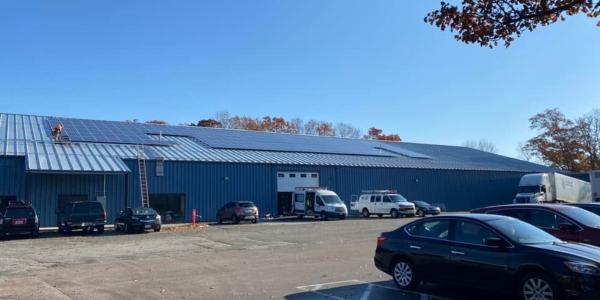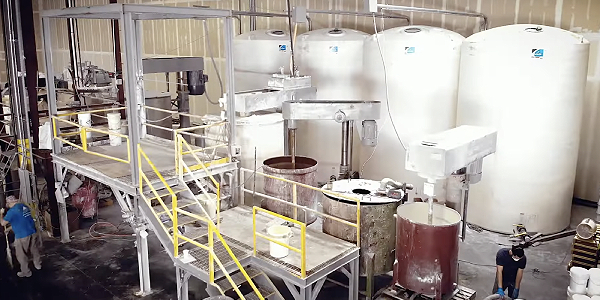Roofs of the Future: Unleashing Solar Power in Style With Standing Seam Marvels!

By Dale Nelson President, Roof Hugger, LLC.
Solar panels are the way of the future and every building owner from commercial to residential should start thinking about getting on board.
Roofs are necessary for humanity. They are truly the only thing standing between us and the harsh elements that mother nature can throw our way. Sooner or later though, they need to be replaced. Metal roofs are becoming a popular choice for roofing projects these days and for good reason. The future is calling for there to be a roof that will do more than just be a roof. We need a roof that can generate power for us as well. That’s where solar comes in.
There has been a steady decline in the price of photovoltaic (PV) panels and a steady increase in the demand for electrical power. California has recently mandated all new homes will have solar panels on them. Commercial/Industrial buildings can’t be far behind. On the government side of things, there seems to be little or no appetite for the construction of new power plants, nuclear or fossil fuel. This means supply/demand gap must be filled somehow... so guess what, your home or building is going to be part of the solution.
Allied Market Research acknowledged this recently, valuing the global photovoltaic market in 2018 at $53.9 billion, they estimate the market will grow by an average of 25.1% annually for a 2026 market value of $333.7 billion. What better place to have these power generating panels than on the roofs of homes or large commercial/industrial buildings.

Knowing PV is coming down the road makes choosing a “new” roof, when the old one needs replacing, a more encompassing decision.
If you have an older commercial metal building, chances are that you have a thru-fastened metal roof. Commonly a 26 ga., 12” o.c. “PBR” roof. The ever-faithful PBR (purlin bearing ribbed) panel, still in broad use today, it is a structural, ribbed panel with major corrugations 1.25” – 1.50” tall and 12” o.c. This roof has been and continues to be a very functional, long life, utility type roof that covers millions perhaps billions of S.F. of typically budget driven buildings.
But now it’s time to reroof that old PBR covered building, what should you do? Retrofitting over the top of the existing PBR will give you some excellent options. The Roof Hugger framing system will allow you to meet the latest building code requirements, it can add strength to the existing purlins to overcome the added weight of the new roof and future photovoltaics. Importantly, this will also allow you to upgrade from the old PBR roof to a new standing seam roof.
Yes, standing seam roofing is a bit more expensive but it provides many advantages that will serve you well in the future. Standing seam panels are attached using sliding concealed clips, normal expansion and contraction can occur without panel damage. Unlike PBR systems, concealed clip attachment also means there are a minimal number of exposed fasteners penetrating the roof. High “R” value fiberglass or rigid insulation roof assemblies are easily accomplished with standing seams roofs allowing for much higher R-Values.
One understated benefit is that many different roof accessories can be mounted to a standing seam roof without penetrating the panels. Photovoltaics can be attached with roof clamps that can easily support the power generating panels without putting any holes in the roof. Another unique benefit is that an independent study commissioned by the Metal Construction Association has shown that a new zinc/aluminum finished standing seam roof would have an expected service life in excess of 60 years, approximately twice the life of the photovoltaic panels.
That is an important distinction because other roofing materials will not last as long as the PV panels, unlike long life metal roofing. Metal eliminates the huge expense to remove the PV panels, remove the old failed roof, install a new roof and reinstall the PV panels. Unlike shingles, TPO and other conventional roof coverings, standing seam roofs do not require numerous support brackets that penetrate the roof surface to support the PV system, they just clamp to the panel ribs.
Even if you are not ready to add PV today, your new roof will be ready and you could have up to 25 years to decide. Your now not so new roof will still outlast the solar panels being mounted.
My Gypsy fortune teller tells me that eventually we are all going to have our own mini rooftop power plants, generating electricity to offset our individual needs and/or to sell back to the grid to assist the community. The type of roof you will be key in minimizing long term maintenance and providing you the greatest number of future options. Making that decision to upgrade to standing seam will pay you back many times over during its life cycle. Go ahead and take a peek into your crystal ball!
Original article source: Roof Hugger
Learn more about Roof Hugger in their Coffee Shop Directory or visit www.roofhugger.com.






















Comments
Leave a Reply
Have an account? Login to leave a comment!
Sign In